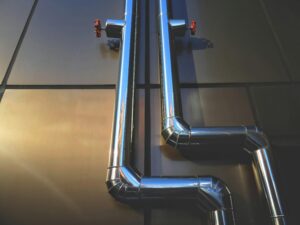
Water hammer, a common plumbing issue in high-rise buildings, occurs when a sudden change in water flow creates a loud, jarring noise. This phenomenon can lead to significant damage to pipes and fittings. As urban construction evolves, so do the solutions to mitigate water hammering.
In this article, we will explore cutting-edge innovations designed to reduce noise and prevent the costly consequences of water hammers in high-rise plumbing systems.
Understanding Water Hammer
As per Chemical Processing, a water hammer, or fluid hammer, is a pressure created due to a sudden change in fluid momentum in pipes. When fluid is suddenly stopped, its momentum is converted to potential energy creating pressure. The pressure created causes the pipes to vibrate, often leading to damage over time.
Water hammering can also lead to a disastrous pipe blast that can lead to expensive downtime and probable losses. This issue is more common in high-rise buildings where water pressure is higher and pipes are longer, intensifying the shockwave.
Traditional Solutions to Water Hammer
Traditional solutions to water hammers typically focus on absorbing or redirecting the pressure surge. One common method is the installation of air chambers or expansion tanks in the plumbing system. These devices contain air that acts as a cushion, absorbing the shockwave and preventing damage to the pipes.
According to ScienceDirect, the application of parallel bypass tubes made of rubber was studied to check its effect on pipes. Around 92 experiments were performed to assess the effect of the flexible tubes’ lengths, elasticity modulus, and internal volumes. The results showed that the installation of these flexible pipes considerably reduced the water hammer pressure.
Another solution is the use of water hammer arrestors, which are mechanical devices designed to dissipate the pressure surge. While effective, these methods can be less reliable over time and may require maintenance or replacement to ensure continued performance in high-rise plumbing systems.
Why might traditional solutions be insufficient for high-rise buildings?
Traditional solutions may be insufficient for high-rise buildings because of the increased water pressure and longer pipe runs, which amplify the force. Air chambers and arrestors may not provide enough cushioning or may wear out over time, making them less effective in these systems.
Innovative Acoustic Solutions
Innovative acoustic solutions have emerged as effective methods for mitigating water hammers in high-rise plumbing systems. A prominent approach involves using acoustic dampers designed to absorb and dissipate the energy from the water hammer, significantly reducing noise levels. These dampers are strategically placed in the plumbing system to counteract the pressure surges that lead to disruptive sounds.
Additionally, modern plumbing technologies now incorporate sound-absorbing materials that can line pipes and joints, further minimizing noise transmission. The integration of these solutions enhances the comfort of residents. It also contributes to the longevity of the plumbing infrastructure by reducing wear and tear caused by pressure fluctuations.
To further improve efficiency, advanced listening devices play a critical role in diagnosing plumbing issues. According to Trent Cooke, owner of 24/7 Plumbing Co., LP, “Our skilled plumbers use state-of-the-art listening devices to detect the distinct sound frequencies made by escaping water to accurately find leakage.”
These innovative techniques enable plumbing professionals to quickly identify and address issues before they escalate. This ensures a more efficient and peaceful living environment in high-rise buildings.
What new technologies are being used to reduce water hammer noise?
New technologies, such as advanced hydraulic shock absorbers and smart water pressure regulators, are being used to reduce water hammer noise. These systems dynamically adjust the pressure to prevent sudden surges, providing more consistent flow and preventing the shockwaves that cause noise and potential damage.
Impact of Innovations on Building Codes and Standards
Innovations in water hammer reduction technology are influencing building codes and plumbing standards. As newer, more effective solutions emerge, codes are evolving to incorporate these advancements, ensuring that high-rise buildings meet safety requirements.
According to the Congressional Research Service, building codes are mainly for the design, structure, alteration, materials, supervision, and performance of new constructions. Usually, the codes do not cover the infrastructure of the building, that is, the physical network providing basic facilities to the residents.
However, when the infrastructure is running through the building, these codes apply to some components of infrastructure like electric wire and plumbing. For example, the adoption of pressure-regulating valves and advanced arrestor systems in plumbing is becoming more common in new construction projects.
These technologies not only address water hammer more effectively but also promote energy efficiency and reduce maintenance costs. As a result, building codes are adapting to ensure that modern plumbing systems are both sustainable and capable of handling complex urban environments.
Are there any emerging trends in plumbing design related to acoustics?
Emerging trends are focusing on acoustics to create quieter, more efficient systems. Innovations such as soundproof piping materials, vibration-dampening mounts, and advanced pressure management devices are being integrated to minimize noise. These trends are especially prevalent in high-rise buildings, where noise reduction is crucial for occupant comfort and regulatory compliance.
Benefits of Addressing Water Hammer in High-Rise Buildings
Addressing water hammers in high-rise buildings offers several benefits, including enhanced occupant comfort and reduced noise disruptions.
According to Britannica, unwanted or excessive sound, such as that of water hammers in high-rise buildings, can have deteriorating effects on humans. It also affects pets, wildlife, and overall environment quality. The human can hear the sound ranging from 0dB to 140 dB. Sound with about 35dB is ambient for the human ears. However, continuous sound of any kind can be tortuous.
By mitigating the loud banging sounds caused by pressure surges, building residents experience a quieter living environment. Additionally, preventing water hammering reduces the risk of long-term damage to pipes, fittings, and appliances, resulting in lower maintenance and repair costs.
Properly addressing water hammer also extends the lifespan of plumbing systems, ensuring more reliable performance and compliance with modern building codes. Overall, these solutions contribute to a safer, more efficient, and cost-effective plumbing infrastructure in high-rise buildings.
Advancing Plumbing Solutions for High-Rise Buildings
Innovative technologies are transforming how water hammer is managed in high-rise buildings, ensuring quieter, more efficient plumbing systems. By adopting these modern solutions, building owners can enhance comfort, reduce maintenance costs, and protect infrastructure. As building codes evolve, embracing these innovations will lead to safer, more durable plumbing systems for the future.





